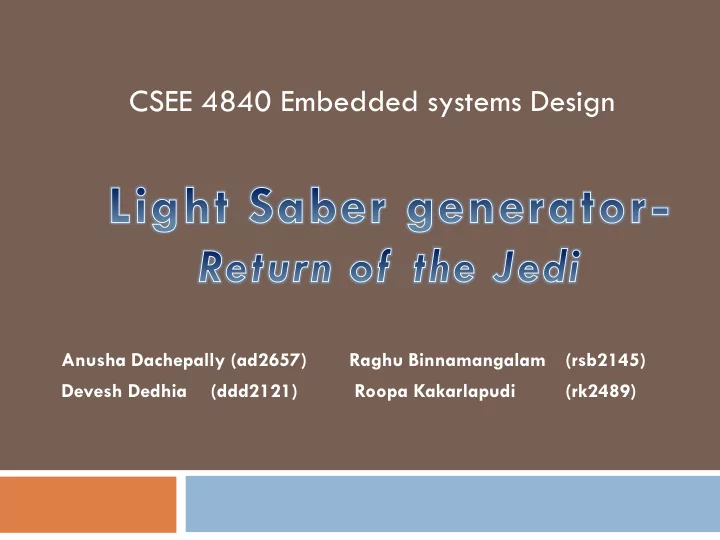

CSEE 4840 Embedded systems Design Anusha Dachepally (ad2657) Raghu Binnamangalam (rsb2145) Devesh Dedhia (ddd2121) Roopa Kakarlapudi (rk2489)
Overview Motivation Goals Real Time Video Display Color detection Light saber generation Real time video processing Processing at 60 fps
Motivation To learn integration of hardware and software Real time video processing on the FPGA board Inspired by Luke Skywalker (Star wars!!)
Objectives To capture video in real time of a person holding a sword Do real time video processing at 60 fps Replace the sword with a light saber on the VGA display
System Architecture YCbCr to RGB 422 ITU To XY 444 Detection A RAM Initiation C D Delay a V timer m 7 e VGA Controller 1 Locked r TD_HS Avalon 8 Detector a ADV VGA TD_VS Communicator 1 7123 Display I2C_SCLK I2C_AV AVALON BUS Config I2C_SDAT NIOS
Timing diagrams
Timing diagram 1 TD_VS 16 ms ( 60 fps) VGA_VS
Timing Diagram 2 TD_HS Fill up 1 line buffer VGA_HS Read 1 line buffer
Timing diagram 3 (Software) TD_VS 1. Generation of light saber 2. Filling up a RAM for communication with hardware TD_HS Read blue/green data
Real time Video Display 60 fps display To emulate real time video No frame storage SRAM not dual ported SDRAM is a time deterrent Real item display on the fly Usage of 2 line buffers Swap between the 2 line buffers Avoids loss of information No interlacing replicating even/odd frame
Color detection Conventional approach Euclidean distance Intense computations hence delay Our approaches RGB vs YCrCb RGB has varying threshold with varying intensity of light YCrCb has greater tolerance
Light saber generation Find centre of mass for ends of sword
Light saber generation Calculate the slope of the line θ
Light saber generation Use a predefined sword width and halo width
Light saber generation Filling the coordinate table x1 x2
Software Design Centre of mass calculation Using theta calculations find the four edge points of the light saber for a predefined width. Use a table to store the X1 and X2 for each line displayed by the VGA.
Design challenges For real time video display Horizontal sync and Vertical sync w.r.t incoming video from ADV 7181 Achieving 60 fps Making the system work without frame buffers Deal with multiple clock domains
Design challenges(contd..) Floating point calculations Line drawing algorithms Synchronization with the VGA module in hardware Hardware signals are sampled more than once
Lessons learnt Start early DE2 Terasic real time video code is all junk Design timing diagrams before implementation Conventional measuring techniques like CRO are Life savers More time for debugging
May the force be with you!!!
Thank You
Recommend
More recommend